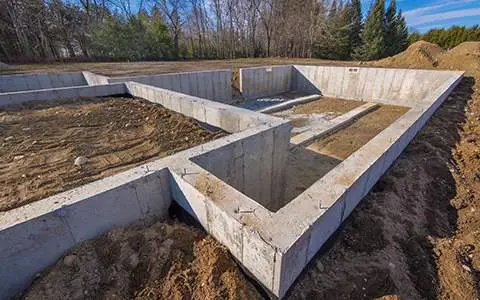
Surface Mount
Surface Mount Foundations are the least expensive option in home foundations. Primarily used for manufactured homes, due to this type of home being constructed in such a way the weight of the home is barred by the beam structure of the home.
Canada has set standards and specifications for surface mount homes which are part of all local communities building codes. The standards mandate that moisture under the home is managed as well as the home is on a solid, level site. A surface mount foundation needs to be constructed to the code by a professional installation company. Once the foundation is complete the home may then be blocked onto the foundation, either by metal stands or ABS blocks and wood planks. The final step is that the home is fastened to the ground with straps anchored into the ground.
To complete the appearance, manufactured homes will normally have a “skirt” around the homemade up of wood or panels of vinyl.
Regardless of what type of foundation you have, a good home insurance plan is vital to cover the cost of foundation repairs or other damages to your home. AMC Insurance offers affordable plans, so contact us for a free home insurance quote today.
Slab Foundation
Slab foundations are the most commonly used foundations today. It is as the name suggests, a slab of concrete that normally 4 to 6 inches thick on average but much thicker on the edges. The edges can be up to 24 inches thick. Installation of a slab foundation is one of the easiest to complete and can be poured in just a single day.
A slab foundation does not include a crawlspace or basement underneath. Due to the characteristics of this type of foundation they can only be installed on a graded surface because the foundation could sink or settle on an ungraded surface. With the foundation being right on the ground, rodents and insects are normally not a problem as there is no space under the foundation for nests to be made.
Disadvantages include cracking and the repair of any plumbing. Large variations of weather and moisture can lead to cracking, thus it is important to maintain a constant moisture level. With no crawlspace or basement, the plumbing is located below the slab so any leaks require a jackhammer to get to the leaks.
Crawlspace Foundation
A crawlspace foundation differs from a slab foundation because it is not placed directly on the ground, the average crawlspace foundation is 2 to 4 feet above the ground. This type of foundation is great for areas with high moisture content where water can build up. With the foundation above the ground, supported by walls extending from the ground from the footings, the repair of plumbing and other utilities.
As the name implies, standing up is not possible in the crawlspace. The floor of a crawlspace can either be a concrete slab or crushed rock. Though it will take longer than a slab foundation to install, a crawlspace foundation is less expensive than a basement foundation.
Basement
A basement foundation is one of the most common due to the added functionality it provides to a home. The basement is the same size as the footprint of the home normally, but it is possible to have a slab portion under some areas like a garage or workshop.
The floor of the basement is in most cases, a slab, and the walls are poured out of concrete to make the basement waterproof. As with a slab foundation, the moisture level and unsettled soil are factors in choosing this type of foundation. A basement foundation takes 2 to 3 days to pour and then you need to give another week for the concrete to harden.
Building codes in BC require basements to now be insulated and drywalled, this adds to the cost and time of construction. It is no surprise that this is the most expensive foundation type.
A complete basement foundation adds square feet to the living area of your home and can either be a finished or unfinished basement. How this area is used is up to the homeowner and the options are endless.
Insurance and Foundations
Your home insurance protects your home in case of many different types of circumstances. As with some other things like earthquakes, not everything is covered.
Insurance will cover these foundation-related issues in most cases but check with your home insurance agent for specifics on what is covered with your foundation.
- If your property is destroyed and needs to be rebuilt, foundation repairs could be part of the process and then included in your coverage.
- If your foundation is damaged due to another covered risk, like plumbing, fire, or an explosion, your policy should cover you.
There are also instances where your home insurance will not cover your foundation:
- Earthquake and Flooding will not be covered unless you have an insurance policy covering those perils
- General wear and tear, basically time, is not covered.
AMC Insurance is happy to answer additional questions about home insurance and what it covers. We also invite you to read about insurance for landlords and renters and where the responsibility falls when certain damages occur on rental properties.
Signs of a Bad Foundation
- Foundation cracks, wall/floor cracks
- Foundation sinking
- Doors that stick or don’t open and close properly
- Gaps around window frames or doors
- Sagging or uneven floors
